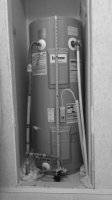Deeiche
New Member
19 year old Intertherm Electric, can't find anode. There is a knockout and two plugs on top cover. I figure two plugs is for foam insulation blowin, there is nothing under the knockout but foam insulation.
Could the anode be hidden under the foam insulation where the knockout is?
I own a 19 year old manufactured home with an Intertherm Electric water heater in Northern New Mexico, the home came with the land when I bought it several years ago as a weekend getaway. A couple weekends ago I visited and realized no hot water. Thinking the worst the first thing I looked into was replacing water heater, with further knowledge I found out if the tank isn't heating it's pretty straightforward to replace the elements, thermostats and anode. So I bought replacement thermostats, elements and anode at HD and headed up for a day long project. What I found when I got there was the over temp switch on upper thermostat had popped, so I reset the over temp switch, drained the water heater of a lot of black sediment and chunks. I then looked for the anode but could not find it.
FWIW, some previous owner had cranked the temp settings to the max on upper/lower thermostats. I turned it down the 120 degree setting. It used to "pop and crack" really loudly, now there is some noise, but a lot less since I drained it.
Could the anode be hidden under the foam insulation where the knockout is?
I own a 19 year old manufactured home with an Intertherm Electric water heater in Northern New Mexico, the home came with the land when I bought it several years ago as a weekend getaway. A couple weekends ago I visited and realized no hot water. Thinking the worst the first thing I looked into was replacing water heater, with further knowledge I found out if the tank isn't heating it's pretty straightforward to replace the elements, thermostats and anode. So I bought replacement thermostats, elements and anode at HD and headed up for a day long project. What I found when I got there was the over temp switch on upper thermostat had popped, so I reset the over temp switch, drained the water heater of a lot of black sediment and chunks. I then looked for the anode but could not find it.
FWIW, some previous owner had cranked the temp settings to the max on upper/lower thermostats. I turned it down the 120 degree setting. It used to "pop and crack" really loudly, now there is some noise, but a lot less since I drained it.
Last edited:

